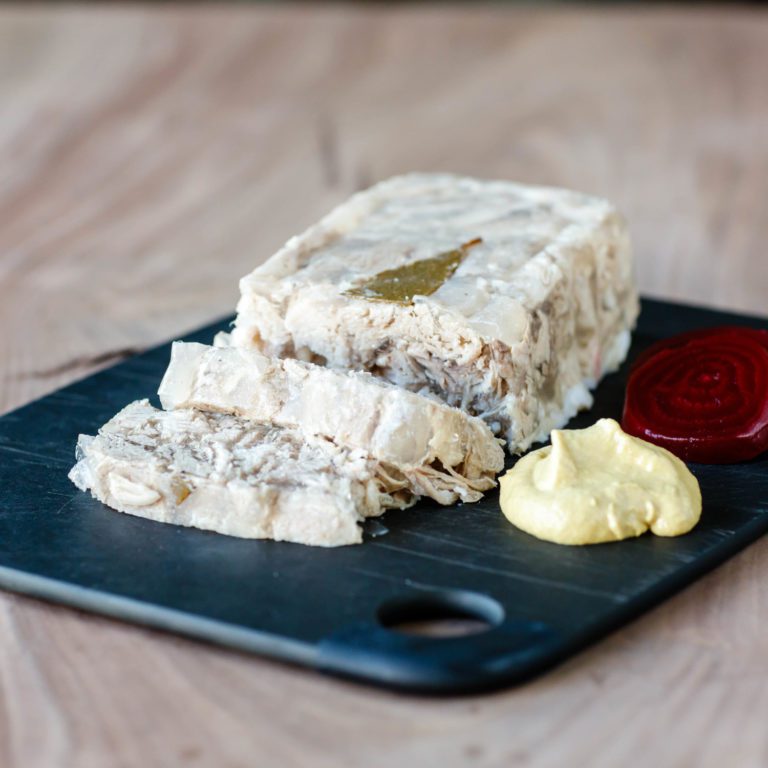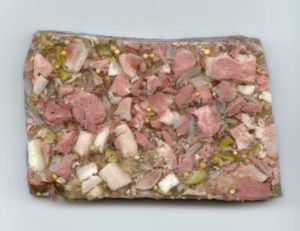
Head cheese recipe is an eastern European delicacy that originated somewhere around the middle ages. It is also referred to as a meat jelly as it uses the head meat of animals such as pigs, calves or even sheep. The Head cheese recipe is not really cheese but rather it is a jelly made out of animal meat.

The traditional recipe uses a pig head and sometimes the feet and it is prepared by removing all the unwanted bits from the pig head such as the eyes, ears and brain, seasoned with spices, salt and onions and then simmering in a large pot until the meat is tender and falls off the bone.
Then this meat is placed in a mould and covered with the stock. The collagen content released from the pig and present in the stock acts as a gelatinous agent thus helping it to bind and form a jelly-like substance.
Contents
How is head cheese served?
Head cheese is usually eaten cold such as:
- As a spread with thin crackers.
- Head cheese can be served as a terrine.
- Slice off a thick piece of head cheese and place it between two slices of bread to make a delicious sandwich. Head cheese goes well with mustard and horseradish.
- Serve it as a part of a charcuterie board.
How to store head cheese recipe?
Head cheese can be stored in the freezer for up to 2 months in an airtight container.If it is stored in the refrigerator, it has to be consumed within 3 days.
What is the difference between hog head cheese and head cheese recipe?
Hog head cheese varies from head cheese in that it is always prepared using only pig head meat while head cheese may also use sheep or calf head meat.
Head cheese recipe variations
- Head cheese can be prepared by first picking the head meat in vinegar, this is also called souse.
- Similarly in the Caribbean, they pickle the meat using lime juice rather than vinegar
- You can also prepare tongue head cheese by using pieces of the animal tongue in addition to the head meat, while this does give a different texture and taste, remember that the outer skin has to be removed as it is bitter. tongue meat also takes longer to cook as compared to head meat.
- You can also make blood head cheese with the addition of a little bit of the animal blood thus giving a richer, full-bodied taste.
- You can also prepare head cheese recipe using pigs feet rather than head meat, this is called sulz.

Ingredients to make Head Cheese Recipe
For the boil
- Pigs head 1
- Diced celery 3 stalks
- Diced carrots 2
- Minced garlic 6 cloves
- Diced yellow onion 1
- Salt 1 tbsp
- Black pepper 2 tsp
- Dried thyme ½ tsp
For the filling
- Boiled pig stock 8 cups
- Finely diced carrots 4
- Apple cider vinegar 3 tbsp
- Salt 3 tbsp
- Black pepper 3 tsp
- Dried thyme 1 tsp
- Lemon juice 3 tbsp
- Chopped rosemary ¼ cup
Equipment needed for Head Cheese Recipe
- Large stockpot
- Loaf pans
- 1 lb bag of uncooked rice to use as a weight
How to Make Head Cheese Recipe?
- Thoroughly clean the pigs head, shave and remove the organs. Place it in a large stockpot along with the garlic, onion, celery, carrot, salt, black pepper and thyme and cover it with water and let it boil for 5 hours.
- Once it is done and the head has cooled, remove all the meat bits and place the skull back in the pot and allow to boil for another 5 hours.
- Discard the skull and drain the liquid through a fine sieve or cheesecloth. Discard the vegetables or any other bits that are stuck to the sieve.
- Cut the meat chunks into 1 inch pieces and set them aside.
- Now take 8 cups of the liquid and allow to simmer, add in your carrots, thyme, salt, black pepper and apple cider vinegar
- Once it has simmered for at least 15 mins, add in the lemon juice and rosemary and turn off the heat.
- Line a loaf pan with plastic wrap and start layering the meat into it.
- Then pour the liquid and tap the pan on a flat surface so that the liquid goes all the way through.
- Cover with plastic wrap and place the weight on it and refrigerate overnight and enjoy!
Summary
And that’s a wrap for our Head Cheese recipe! We hope you enjoyed making and eating this traditional dish. If you have any questions or comments, feel free to reach out. Until next time, happy cooking.